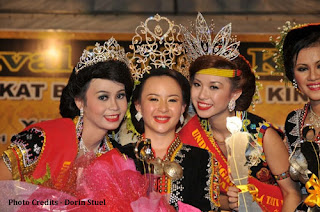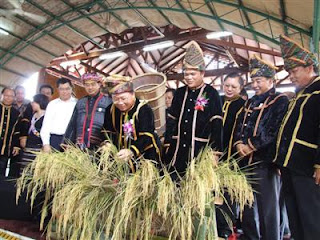For my assignment 1, I'm deciding to do a festival called Tadau Kaamatan (Harvest Festival) which is from my homestate.
So basically, The word Kaamatan is derived from the root word tomot, a Kadazandusun term for harvest. Kaamatan festival is an annual event in the cultural life of the Kadazandusuns of Sabah since time immemorial. In its deepest sense, Kaamatan festival is a manifestation of Creator and Creation relationship, as well as Inter-Creations relationship. It embodies the principal acts of invocation of divinities, appeasing, purification and restoration, re-union of benevolent spirits, and thanksgiving to the Source of All. It is part of a complex wholesome Momolian religious system centered on the paddy rites of passage and the life cycle of Bambarayon – the in-dwelling spirit of paddy. It is celebrated usually around end of May, every year.
The festival is observed in 6 rituals stages:
The Kumogos Ceremony
Before a harvest begins, a Bobohizan/Bobolian (ritual specialist) will select and tie-up 7 stalks of the best rice from a plot of rice field. These stakes of rice will only be harvested after the particular plot of field has been completely harvested. The 7 stalks of rice will then be scattered all over the rice field. This gesture is to inform the other spirits who may be present among the rice field not to make any disturbance when the harvesting work is to commenced and each of them will be given something after the harvest.
The Kumotob Ceremony
From the area which has not yet been harvested to the Bobohizan/Bobolian will select 7 stalks of the best rice. The selected stalks are then tied up together and placed in a tadang (a type of basket for keeping rice). The rest of the rice in the field are then harvested and the rice are turned into seed for future planting season.
The Posisip Ceremony
The Bobohizan/Bobolian goes to a rice hut together with the 7 stalks of rice which is tied up and placed in the tadang. While reciting chants she takes out the bundle of rice stalks and insert them in a bamboo pole kept in the tangkob. The recital of the chants is to call the spirit of the rice to stay in the rice hut until the next planting season, i.e. when the rice spirits are called to the rice field again.
The Poiib Ceremony
In the rice hut the Bobohizan/Bobolian carefully pours the rice into the tangkob. This process is repeated for a number of times until all the rice has poured into the tangkob. The Bobohizan/Bobolian then recite chants appealing to the rice spirits to keep watch over the rice stored in the tangkob.
The Magavau Ceremony
This is the most important ceremony in the sequence of events of the harvest festival. This focuses in the restoration of Bambazon/Bambarayon as well as offering food to Bambazon/Bambarayon. In the olden days, the Magavau ritual is performed in the padi field on the night of the first full moon after the harvest. Nowadays, this ritual is carried out in the house of the owner of the field.
The Humabot Ceremony
 This is the final stage of the observation of the harvest festival and is in the form of merry-making and entertainment. This ceremony is now celebrated at village, district and state levels annually (30 - 31 May). A variety of entertainment and activities in the form of dances and traditional sports are held and the climax of the event is the selection of the Unduk Ngadau (Harvest Festival Queen). The Unduk Ngadau symbolizes Huminodun, the sacrificed daughter of Kinoingan.
This is the final stage of the observation of the harvest festival and is in the form of merry-making and entertainment. This ceremony is now celebrated at village, district and state levels annually (30 - 31 May). A variety of entertainment and activities in the form of dances and traditional sports are held and the climax of the event is the selection of the Unduk Ngadau (Harvest Festival Queen). The Unduk Ngadau symbolizes Huminodun, the sacrificed daughter of Kinoingan.The rituals described above are typical of the Kadazan-Dusun of the Penampang-Papar area. Other dusunic groups, the murutic groups of the interior and the paitanic groups in the east have different rice harvest rituals. For example, the Lotud Dusun have a series of eight ceremonies - Mansalud, Monuras, Tumakau, Matang, Mongoi Rumali, Mogimpuun, Sumondod and Monumbui. The essence of this ceremony however is the same, that is of thanksgiving for a plentiful harvest.
(Reference: http://en.wikipedia.org/wiki/Kaamatan)
These are are the images I am going to use for my festival assignment 1:
 |
| Mount Kinabalu |
 |
| Padi field |
 |
| Wakid basket |
 |
| Sumazau Dance |
 |
| Tempayan |


No comments:
Post a Comment